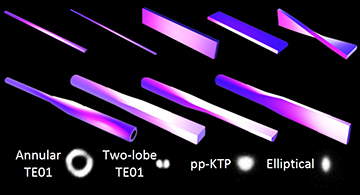An international research team has developed a method for fast fabrication of variable-cross-section waveguides for integrated photonics—potentially useful for on-chip functionalities such as mode conversion, polarization control and beam rotation. [Image: B. Sun] [Enlarge image]
Advances in integrated photonics in large part rest on the ability to embed low-loss optical waveguides into chips. And engineers have made huge strides in recent years in approaches for carving out these tiny light channels—both through CMOS-friendly etching techniques in silicon photonics, and through femtosecond laser waveguide writing in other materials.
Many techniques for creating such micron-scale optical waveguides, however, have a disadvantage: It’s difficult to build waveguides whose cross-sections vary in a controllable, tailored way along the propagation direction. That’s an unfortunate limitation, as the ability for more exotic, precisely controlled waveguide shapes could open new avenues for polarization manipulation, efficient mode conversion and other functionalities on photonic chips.
Researchers from the United Kingdom, Israel, Austria and China have now unveiled an intriguing approach for building such high-performance, variable-cross-section waveguides (Light Sci. Appl., doi: 10.1038/s41377-022-00907-4). The team’s spherical phase-induced multicore (SPIM) waveguide technique uses a combination of femtosecond laser writing and adaptive optics to carefully shape the laser focus on the fly, and thus to precisely control the refractive-index profile of the fabricated waveguide.
Using the technique, the team was able to fashion, in glass, low-optical-loss, high-performance waveguides in a variety of shapes—and to do so in a matter of minutes of fabrication time. The researchers also demonstrated use of these waveguides in functions such as beam rotation, polarization control, and mode conversion for connections with single-mode fiber.
A tricky problem
Numerous techniques already exist for adding some cross-sectional variability to waveguides, but all of them, that authors of the new study point out, have their disadvantages. For silica-on-silicon waveguides, for example, conventional 2D etching techniques aren’t easily adapted for 3D variation.
In femtosecond laser writing, meanwhile, variable-cross-section waveguides can be built with what the authors call the “classic multi-scan” technique, which involves a stack of multiple laser scans to enable waveguide tapering and other geometries. But the technique provides a highly anisotropic result, with fine control of less than half a micron in one transverse direction but coarse resolution of as much as 8 microns in the other. This can lead to weird refractive-index structures and positive and negative refractive-index changes in regions of the same waveguide.
Adaptive optics to the rescue
To get past these limitations, the team—including researchers from the University of Oxford and Imperial College London, UK, Ben-Gurion University of the Negev, Israel, the Medical University of Innsbruck, Austria, and Jilin University, China—took the femtosecond-laser-writing classic multi-scan technique as a starting point. The researchers then used adaptive optics to substantially improve that technique’s ability to carve finely shaped, variable-cross-section waveguides.
The team began by aligning a spatial light modulator (SLM) in front of a 0.5 NA objective lens, focusing pulses from a 514-nm, 170-fs, 1-MHz-repetition-rate laser. The SLM allowed the team to alter the light’s phase pattern to correct aberrations introduced by the system setup and the refractive-index mismatch between the air and waveguide. But it also gave the researchers the ability to adjust the primary spherical aberration of the beam’s intensity profile—the “Z11” mode, in the language of the Zernike polynomials used in adaptive optics.
Through extensive experiment and trial and error, the team found that tweaking Z11 in the negative direction sent more energy to the bottom of the laser focus carving out the waveguide. That, in turn, enabled much more refined control of the waveguide’s refractive-index profile in each laser scan, and higher resolution in both the horizontal and vertical direction—a fact confirmed by the team using 3D tomographic microscopy measurements. Adjusting the Z11 mode with the SLM also resolved the complex regions of negative and positive refractive-index changes that tend to bedevil the conventional multi-scan technique, according to the authors.
Rotation, polarization and mode control
The researchers put their system to work fabricating a variety of waveguide shapes in borosilicate glass. These included twisted waveguides that served as beam rotators; tapered and flattened waveguides to serve as adiabatic mode converters and fiber couplers; and on-chip structures that enabled polarization control for specific targeted wavelengths.
The team’s measurements suggested that the waveguides sported relatively low propagation losses of 0.14 dB/cm and “very low coupling loss of 0.19 dB.” In one experiment, more than 95% of light was coupled from a single-mode fiber tip to the circular facet of one of the team’s SPIM-waveguide mode converters. The waveguides built using the process apparently can operate across a wide swath of wavelengths from visible to infrared. And the short time it takes to fabricate the SPIM waveguides—reportedly one to two minutes—could make the technique useful in rapid prototyping.
The researchers see particular promise for the SPIM-waveguide technique in fashioning structures for on-chip mode conversion and mode matching, crucial in information traffic management and optical coupling for integrated photonics. That could prove especially interesting, the team believes, in applications for quantum technology, where, in the words of a press release accompanying the work, the reduced coupling losses could “greatly improve the efficiency of quantum chips” in linking up with quantum light sources.

